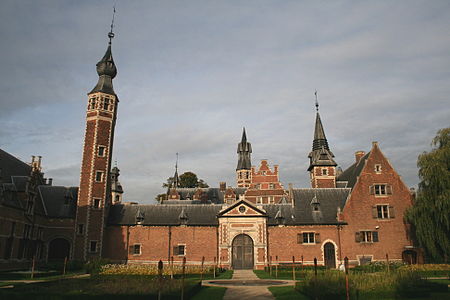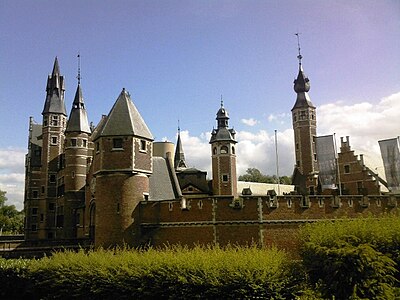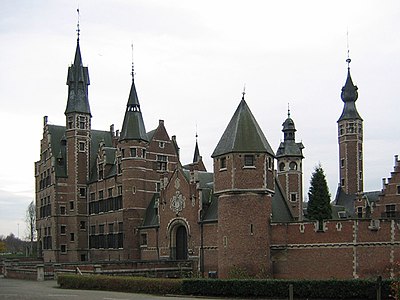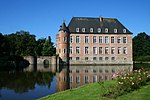
Oostkamp is a municipality located in the Belgian province of West Flanders. The municipality comprises the villages of Hertsberge, Oostkamp proper, Ruddervoorde and Waardamme. On January 1, 2019, Oostkamp had a total population of 23,698. The total area is 79.65 km² which gives a population density of 289 inhabitants per km².

Deinze is a city and a municipality in the Belgian province of East Flanders. It comprises the city of Deinze, and the towns of Astene, Bachte-Maria-Leerne, Gottem, Grammene, Meigem, Petegem-aan-de-Leie, Sint-Martens-Leerne, Vinkt, Wontergem, Zeveren, Nevele, Hansbeke, Landegem, Merendree, Poesele and Vosselare. On January 1, 2020, Deinze had a population of 43,580. The municipality's total area is 127.43 km2 (49 sq mi), giving a population density of 342 inhabitants per km².

Het Steen is a medieval fortress in the old city centre of Antwerp, Belgium, one of Europe's biggest ports. Built after the Viking incursions in the early Middle Ages as the first stone fortress of Antwerp, Het Steen is Antwerp's oldest building and used to be its oldest urban centre.

Berchem is a southern district of the municipality and city of Antwerp in the Flemish Region of Belgium. Berchem is located along the old Grote Steenweg that has connected Brussels to Antwerp for several centuries; the town borders the districts of Deurne, Borgerhout, Wilrijk and Antwerp and the municipality of Mortsel. Berchem itself consists of three quarters, Oud Berchem, Groenenhoek and Nieuw Kwartier.

Deurne is the second largest district of the municipality of Antwerp, Belgium, and has 79,627 inhabitants (2019).

D'Ursel Castle used to be the private summer residence of the Duke of Ursel in Hingene in the municipality of Bornem, province of Antwerp, Belgium. Today it is property of the State, and opened to the public.

Vogelsanck Castle is a moated castle in Zolder in the municipality of Heusden-Zolder, province of Limburg, Belgium.
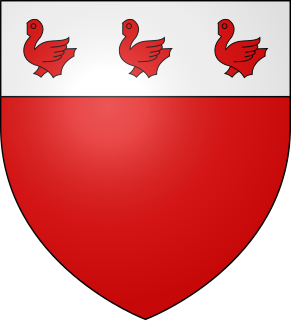
d' Ursel is the name of an important old Belgian noble family of German origin. The chief of the House is styled the Duke of Ursel, others are Count d'Ursel.
Christine Conix is a Belgian architect whose projects have been described as innovative and diverse and creative. She created her firm Conix Architects in 1979 in the Antwerp city of Wilrijk; by 2007, her firm employed 67 people and by 2014, it had offices in Brussels, Warsaw, Rotterdam, Terneuzen, with the head office in Antwerp. In 2013, Conix architects won a contract to rebuild a Moroccan city named Nador to transform it into a center for economics and tourism, which involves constructing critical infrastructure such as houses, schools, and hospitals. Conix Architects designed a renovation and expansion for the Atomium in Belgium, a structure originally built for the 1958 World's Fair in Brussels. It designed the Belgian pavilion at the World Expo in Shanghai in 2010. Her firm won a contest among 28 architectural firms agencies for architectural work relating to the Vrije Universiteit Brussel. Conix believes intuition should play a large role in architectural design, and believes in sustainability, and sees no significant difference between men and women today in the field of architecture. She studied architecture at the Hoger Instituut voor Architectuurwetenschappen Henry van de Velde in Antwerp.

Bornem Castle, also known as the Marnix de Sainte-Aldegonde Castle, is a country house, formerly a castle, located in Bornem, province of Antwerp, Belgium. Bornem Castle is situated at an elevation of 1 meters.

Antwerp is a city in Belgium and the capital of Antwerp province in the Flemish Region. With a population of 520,504, it is the most populous city proper in Belgium, and with a metropolitan population of around 1,200,000 people, it is the second-largest metropolitan region after Brussels.

Ter Worm or Terworm Castle is a castle located in the municipality of Heerlen, Limburg Province, Netherlands. The castle is part of the Terworm estate.
The following is a timeline of the history of the municipality of Antwerp, Belgium.

The Sterckshof silver museum of the province of Antwerp was a museum located in Sterckshof castle in Deurne, Province of Antwerp, Belgium, from 1994 to 2014. It then merged with the Antwerp Diamond Museum to form DIVA Museum for Diamonds, Jewellery and Silver, based in Antwerp city centre.

Borrekens Castle, known also as Vorselaar Castle or Kasteel de Borrekens, is a castle within the municipality of Vorselaar, in the Belgian province of Antwerp.

Couwelaar Castle, also known as De Drie Torekens, is a castle in the Deurne district of Antwerp. The castle is L-shaped and consists of a main building with wings, as well as several outbuildings including a coach house. The main building is characterized by two round towers at the front and a built-in, square tower at the rear. Over the centuries, the castle has been extensively altered and restored several times and has stylistic elements of the Neo-Renaissance and Rococo, among others. Couwelaar Castle is a historical monument.

The Battle of Borgerhout was a battle during the Eighty Years' War, of the Spanish Army of Flanders led by Alexander Farnese, Prince of Parma, upon a fortified camp at the village of Borgerhout, near Antwerp, where several thousand French, English, Scottish, and Walloon soldiers in service of the recently created Union of Utrecht were stationed. It took place during the reconquest by the armies of Philip II of Spain of the Burgundian Netherlands, whose different provinces had united in 1576 under the Pacification of Ghent to drive out the foreign troops and to grant religious liberty to Protestants.

Antwerp Citadel was a pentagonal bastion fort built to defend and dominate the city of Antwerp in the early stages of the Dutch Revolt. It has been described as "doubtlesse the most matchlesse piece of modern Fortification in the World" and as "one of the most studied urban installations of the sixteenth century".
Joost M. A. Caen is a Flemish independent artist and glass conservator since 1982. In his workshop, he creates contemporary stained-glass windows for churches and secular buildings. In 2003 he was one of the first stained-glass artists who incorporate solar cells into a glass creation. This work can be seen in the entrance hall of the District House at Deurne, Belgium. Caen also conserves stained-glass panels and windows, mainly for museums and collectors.
Tram Route 10 is a tram route in Antwerp and nearby Wijnegem. Tram route 10 entered operation in 1873, making it one of the oldest tram routes still active in Antwerp, next to Tram Route 4 (Antwerp) and Tram Route 7 (Antwerp).



